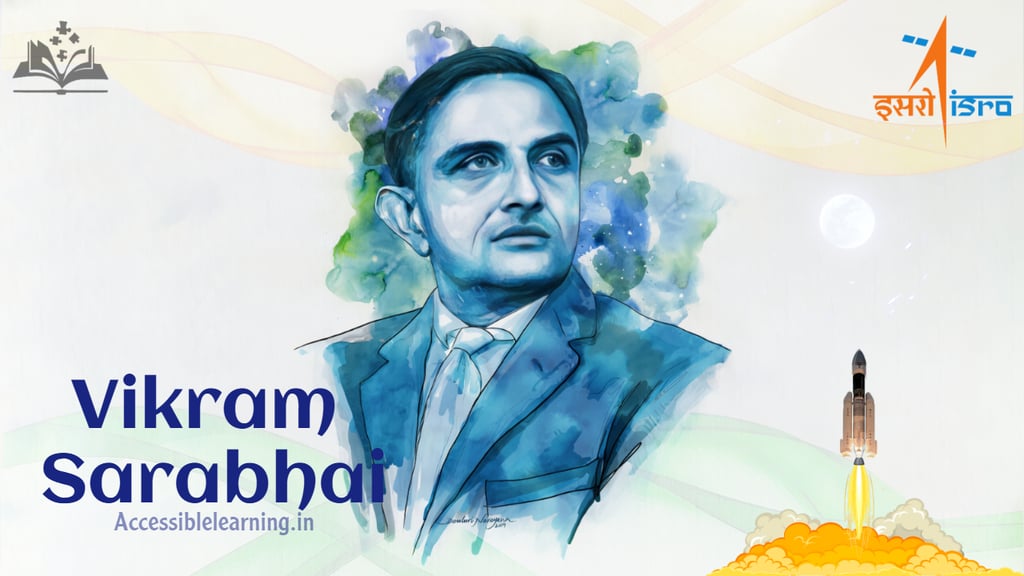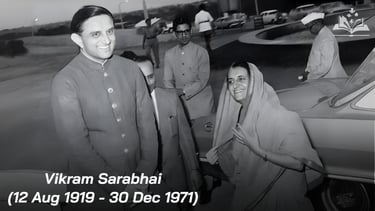
From Cosmic Rays to Satellites: The Inspirational Life of Vikram Sarabhai Ji?!
Vikram Sarabhai Ji, often referred to as the "Father of the Indian Space Program," was a visionary scientist whose groundbreaking contributions in space technology, education, and industrial development helped shape India's scientific and technological landscape. His unparalleled legacy, from founding ISRO to his commitment to using science for societal benefit, has left an indelible mark on the world. This article explores the life, achievements, and lasting impact of Vikram Sarabhai, providing an in-depth guide to his extraordinary journey and transformative vision.
GREAT SCIENTISTISRO/NASAINDIA/BHARATBIOGRAPHYHISTORY
Sachin K Chaurasiya
11/25/20246 min read


Vikram Sarabhai Ji (विक्रम साराभाई), a name synonymous with innovation, vision, and dedication, stands as one of India’s most celebrated scientists and institution builders. Known as the "Father of the Indian Space Program," he transformed India's scientific and industrial landscape, emphasizing the use of space technology for national development. This article delves into his life, contributions, and enduring legacy, offering a comprehensive guide to understanding the genius of Vikram Sarabhai (विक्रम साराभाई).
Early Life & Influences
Vikram Ambalal Sarabhai (विक्रम अंबालाल साराभाई) was born on August 12, 1919, in Ahmedabad, Gujarat, into the illustrious Sarabhai family, known for its wealth, philanthropy, and nationalist fervor.
Family Influence
Growing up in an environment filled with intellectuals, freedom fighters, and progressive thinkers, Sarabhai imbibed values of innovation and service. His parents, Ambalal and Sarla Devi, ensured their home was a hub for cultural and intellectual exchange.
Education
After completing his schooling in Gujarat, Sarabhai pursued higher studies at Cambridge University, earning a degree in Natural Sciences in 1940. World War II briefly interrupted his academic journey, prompting his return to India. Later, he resumed his studies and obtained a Ph.D. in Cosmic Rays under Nobel laureate C. F. Powell at Cambridge. His research laid the foundation for his future work in space science.
Vision & Founding of India’s Space Program!
Vikram Sarabhai was a man ahead of his time. While many doubted India's capacity to venture into space technology, Sarabhai firmly believed in harnessing science for societal progress.
Key Beliefs
Space for Development
Sarabhai advocated using space technology to address real-world issues like education, healthcare, and resource management. He famously said:
"We are convinced that if we are to play a meaningful role... we must be second to none in the application of advanced technologies to the real problems of man and society."
Self-Reliance
He envisioned India becoming self-reliant in science and technology, reducing dependence on foreign expertise.
Establishing ISRO
In 1969, Sarabhai established the Indian Space Research Organisation (ISRO) with a clear roadmap to make India a global leader in space technology.
Early Milestones
Setting up the Thumba Equatorial Rocket Launching Station (TERLS) in Kerala.
Collaborating with NASA for the Satellite Instructional Television Experiment (SITE) to educate rural India.
Developing India’s first satellite, Aryabhata, launched in 1975, posthumously fulfilling his dream.
Institution Building: A Legacy of Excellence!
Sarabhai’s vision wasn’t limited to space exploration. He believed in nurturing ecosystems for science, technology, and education.
Institutions Founded by Vikram Sarabhai
Physical Research Laboratory (PRL)
Established in 1947 in Ahmedabad, PRL became India’s cradle for space science research.
Indian Institute of Management Ahmedabad (IIMA)
Sarabhai co-founded IIMA in 1961, introducing world-class management education to India.
Community Science Centre (CSC)
To inspire young minds, Sarabhai established CSCs to make science education accessible to students.
Space Applications Centre (SAC)
Located in Ahmedabad, SAC focuses on developing satellite-based solutions for communication, broadcasting, and remote sensing.
Collaborations & Global Outreach
Sarabhai understood the importance of international collaboration in accelerating India’s progress.
Partnership with NASA
His association with NASA led to innovative projects like SITE, which demonstrated the power of satellite communication for rural education.
International Recognition
Sarabhai’s work earned him respect worldwide, as he emphasized the peaceful use of space technology for development.
Personal Life: The Man Beyond the Scientist
Vikram Sarabhai’s personal life reflected his multifaceted personality. He married Mrinalini Sarabhai, a legendary classical dancer, and the couple became a beacon of culture and science.
Children
Mallika Sarabhai: A renowned dancer, actress, and social activist.
Kartikeya Sarabhai: An environmentalist and educationist.
Despite his busy schedule, Sarabhai maintained a deep connection with his family and upheld his love for art and culture.

Sarabhai’s Role in India's Atomic Energy Program?!
Apart from his contributions to space science, Vikram Sarabhai played a crucial role in advancing India's atomic energy program.
Chairman of the Atomic Energy Commission
After the death of Homi Bhabha, the pioneer of India's nuclear program, Sarabhai succeeded him as the chairman of the Atomic Energy Commission of India in 1966.
He prioritized the peaceful use of nuclear energy, emphasizing applications in power generation, agriculture, and medicine.
Sarabhai collaborated with international nuclear organizations to ensure India's responsible and innovative participation in global nuclear science.
Vikram Sarabhai’s Unique Leadership Style!?
Sarabhai’s leadership approach was as innovative as his scientific vision:
Mentoring Young Talent
Sarabhai nurtured young scientists, empowering them to think independently and take bold initiatives. His mentorship helped shape future ISRO leaders like A. P. J. Abdul Kalam, who later became a key architect of India’s missile and space programs.
Interdisciplinary Collaboration
He emphasized the integration of science with arts, management, and communication, ensuring that technology served humanity.
Vision for Communication Satellites
Sarabhai was particularly interested in the development of communication satellites to benefit rural and underprivileged communities.
Satellite Instructional Television Experiment (SITE)
This pioneering project (1975–1976) brought educational programs to 2,400 villages in India. It showcased how satellites could bridge the gap between urban and rural education, addressing literacy and developmental challenges.
Contributions to Industrial and Technological Growth
Sarabhai was instrumental in establishing industries that merged research with practical applications.
Indian Textile Industry Modernization
Leveraging his family’s textile business, Sarabhai modernized the industry by incorporating scientific techniques.
Electronics and Automation
He promoted electronics and automation in India, laying the groundwork for future advancements in computing and communication.
Recognition by International Space Community
Sarabhai’s forward-thinking approach earned him accolades and respect worldwide. He was a member of several international scientific bodies, including
The United Nations Committee on the Peaceful Uses of Outer Space (COPUOS)
The International Astronautical Federation (IAF)
Humanitarian Perspective in Science
Sarabhai believed that science should not exist in isolation but must address societal challenges.
Healthcare Contributions
He worked on radiation therapy for cancer treatment, ensuring nuclear science served medical needs.
Energy Solutions
Sarabhai’s focus on renewable and nuclear energy aimed at making India energy-independent.
Enduring Cultural Influence
Vikram Sarabhai’s impact extended beyond science:
His family’s deep involvement in art and culture (especially his wife, Mrinalini Sarabhai) made the Sarabhai name synonymous with India’s artistic heritage.
Sarabhai championed the idea of scientists engaging with the arts, believing creativity was central to innovation.


Fascinating Facts about Vikram Sarabhai
Connection to Mahatma Gandhi
Sarabhai’s parents were close associates of Mahatma Gandhi, and their home was frequently visited by leaders of the Indian independence movement.
The Sarabhai Family's Philanthropy
The Sarabhai family was deeply involved in social welfare. For instance, the Ahmedabad Textile Industry’s Research Association (ATIRA), initiated by his family, was an effort to modernize Indian industries.
Cosmic Rays Research
Sarabhai’s doctoral work on cosmic rays laid the groundwork for his interest in space science. His research revealed insights into high-energy particles from space interacting with Earth's atmosphere.
The Sarabhai Crater
Honoring his contributions to space science, a lunar crater on the Moon’s Mare Serenitatis has been named "Sarabhai."
Global Perspective on Technology
Sarabhai believed that India’s strength lay in adapting global advancements to local needs. His strategy for space technology focused on societal benefits rather than competition in global space exploration.
Lessons from Vikram Sarabhai’s Life
Vision and Pragmatism
Sarabhai demonstrated how a clear vision combined with practical action can drive transformation.
Innovation for Social Good
He redefined innovation, focusing on technologies that directly impact societal well-being.
Collaboration Across Borders
Sarabhai’s work highlighted the importance of global cooperation in science and technology, balancing self-reliance with international partnerships.
Balancing Multiple Roles
Sarabhai seamlessly integrated his roles as a scientist, institution-builder, businessman, and cultural advocate, inspiring others to think beyond conventional boundaries.
Awards and Recognition
Vikram Sarabhai’s groundbreaking contributions earned him numerous accolades:
Padma Bhushan (1966): For his significant achievements in space research.
Padma Vibhushan (posthumously in 1972): India’s second-highest civilian award for his unparalleled legacy.
The Vikram Sarabhai Space Centre (VSSC) in Thiruvananthapuram stands as a testament to his contributions.
Vikram Sarabhai’s Enduring Legacy
Sarabhai’s untimely death on December 30, 1971, at the age of 52, was a profound loss. However, his vision lives on through ISRO’s stellar achievements.
Major ISRO Milestones Inspired by Sarabhai
Chandrayaan Missions: India’s lunar exploration efforts.
Mangalyaan (Mars Orbiter Mission): Showcasing India’s cost-effective and efficient space technology.
Gaganyaan: The upcoming human spaceflight mission
His legacy isn’t just in space programs but in the way India approaches innovation, research, and societal development.

Vikram Sarabhai Ji’s life teaches us the power of vision, resilience, and dedication. He didn’t just dream of India reaching the stars; he built the foundation for it. His approach to using science and technology for social welfare remains a guiding principle for India’s development.
Sarabhai’s legacy continues to inspire scientists, innovators, and dreamers worldwide, proving that with determination and a clear purpose, even the sky is not the limit.
Subscribe To Our Newsletter
All © Copyright reserved by Accessible-Learning Hub
| Terms & Conditions
Knowledge is power. Learn with Us. 📚


